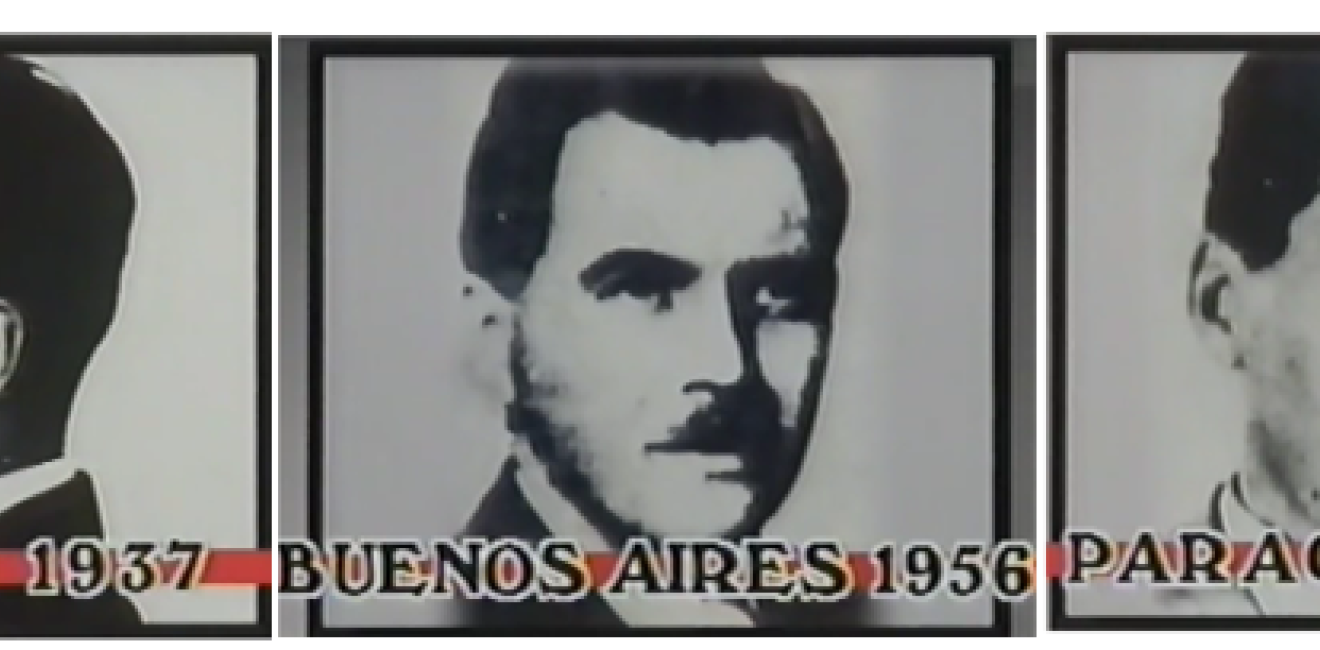
A blog of the History and Public Policy Program
FUGITIVE: Josef Mengele, from left, Nazi Party membership application, Berlin, 1937; German passport photo, Buenos Aires, 1956; Argentine identity card, Asuncion, Paraguay, 1959 Images courtesy San Diego State University Network TV News Research Archive.
By age 85, Eva Kor had lived 75 years after suffering the most horrible moment of her life: the gruesome medical experiments forced on her and her 10-year-old twin sister, Miriam, by a Nazi doctor at Auschwitz, the German World War II death camp.
Kor later created a museum in the United States to foster Holocaust remembrance. She made yearly visits to the Auschwitz site to commemorate its victims. But it was Kor's death this year (July 4) that brought the most renewed notoriety to Josef Mengele, the evil doctor, and his 40-year escape from justice.
After the war, Mengele, the so-called Angel of Death was mistakenly released from custody, fled to South America, and was never punished for his brutal treatment of an estimated 1,500 sets of twin children, even though his actions often resulted in their deaths.
Scarcely mentioned at her death was the role played by Kor and her fellow survivors in successfully reviving the moribund search for Mengele. In effect, they shamed authorities and the world for having allowed the case to lapse.
In January, 1985, the twins organized a 40th anniversary memorial of the liberation of Auschwitz. They staged a mock trial of Mengele in Israel, repeating forgotten details of their painful ordeal. They lobbied the U.S. Congress to pass resolutions insisting that Mengele be found, arrested, and subjected to a proper trial.
It was that challenge that led journalists and investigators to embark on a new worldwide search. We were spurred by the survivors' testimony and a Cold War shadow that had been cast over United States inaction.
The fact that the United States had recruited hundreds of former Nazi scientists to work on space and military projects led to suspicions, fanned by Soviet propaganda, that the Americans harbored a secret sympathy for the Nazi fugitives.
The controversy grew as newspapers and the television networks pursued the story. In a six-month period, American network television news programs broadcast no fewer than 55 stories on the subject of Mengele's crimes and his escape.
On March 6, 1985, ABC News Foreign Editor Walter Porges and I flew to Europe to begin a search that led through six countries and more than 30,000 miles of travel.
In Vienna, we interviewed witnesses who had known Mengele first-hand.
“Arrogant, absolutely arrogant; coldness, absolute cold yet intelligent, no compassion,” said Dr. Ella Lingens, a Viennese physician who had tried to help Jewish friends escape capture and found herself imprisoned and assigned to Mengele’s staff at Auschwitz.
“This lack of any moral and human feeling I've never seen in any other person,” she told me that night in a clinic on the Kaiserstrasse.
For months, we were a small flock of journalists from many countries interviewing government and military intelligence officers, seeking comments from Mengele family members and heads of state, and scanning dormant prosecutor files in Europe, the Middle East, and South America.
Galvanized now by widespread public discussion, American, West German, and Israeli investigators revived cooperation. They pulled clues from tips and served search warrants in Germany that led to Brazil. There they discovered that Mengele, sustained for decades by secret family funding, had suffered a stroke and died February 7, 1979. He was buried anonymously.
On June 21, 1985, the police chief of Sao Paulo declared that Mengele's bones been found, exhumed and expertly identified. After DNA testing, skeptical Israeli analysts drew a similar conclusion.
In the end, thanks to the survivors, Eva Kor among them, the world finally learned that Mengele's body, hidden behind another man's name, had been tracked to earth and denied an artificial absence from history.
Eight years later, the same year her twin sister died, Kor took an unexpected step.
Composing what she called it a “document of forgiveness,” Kor signed and addressed a letter to a former Auschwitz doctor who, in an agreed response, wrote a rare open description of the camp’s deadly gas chamber operations.
“As I did that,” she explained later, “I felt a burden of pain was lifted from me.”
John Martin's article, “In Evil’s Footsteps,” recounts his 1985 search for the Nazi doctor Mengele. It appears in the October, 2019 issue of “World War II Magazine.”
Author

Former Correspondent, ABC News, New York and Washington

History and Public Policy Program
A leader in making key foreign policy records accessible and fostering informed scholarship, analysis, and discussion on international affairs, past and present. Read more


Cold War International History Project
The Cold War International History Project supports the full and prompt release of historical materials by governments on all sides of the Cold War. Read more

Explore More in Sources and Methods
Browse Sources and Methods
Energy and the Fall of Détente

Kissinger, Dobrynin, and the End of the Vietnam War

